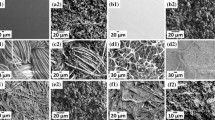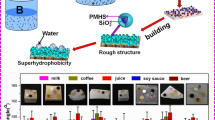Abstract
In this study, we present a strategy to fabricate durable superhydrophobic materials by employing organosilane surface-functionalized quartz sand particles. The quartz sand particles are bonded intimately with diethoxydimethylsilane and triethoxymethylsilane to enhance the mechanical properties of the materials. The obtained materials possess superhydrophobicity with the water contact angle of 158 ± 1° and self-cleaning ability. Moreover, the materials can endure the 6H pencil hardness test and also can keep stable superhydrophobicity under extreme environment conditions of immersion test and mechanical force. Scanning electron microscopy and water contact angle measurement were used to describe the morphological features and explain the obtained surface wettability. The chemical compositions of the materials were confirmed by Fourier-transform infrared spectrophotometer and X-ray photoelectron spectrometer. The appearance of the successful durable superhydrophobic material could yield a prospective candidate for various practical applications.












Similar content being viewed by others
References
Sun T, Feng L, Gao X, Jiang L (2005) Bioinspired surfaces with special wettability. Acc Chem Res 38:644–652
Zhou H, Wang H, Niu H, Gestos A, Wang X, Lin T (2012) Fluoroalkyl silane modified silicone rubber/nanoparticle composite: a super durable, robust superhydrophobic fabric coating. Adv Mater 24:2409–2412
Steele A, Bayer I, Loth E (2012) Adhesion strength and superhydrophobicity of polyurethane/organoclay nanocomposite coatings. J Appl Polym Sci 125:E445–E452
Hsu CP, Chang LY, Chiu CW, Lee PT, Lin JJ (2013) Facile fabrication of robust superhydrophobic epoxy film with polyamine dispersed carbon nanotubes. ACS Appl Mater Interfaces 5:538–545
Liu M, Zheng Y, Zhai J, Jiang L (2010) Bioinspired super-antiwetting interfaces with special liquid-solid adhesion. Acc Chem Res 43:368–377
Wang Y, Xue J, Wang Q, Chen Q, Ding J (2013) Verification of icephobic/anti-icing properties of a superhydrophobic surface. ACS Appl Mater Interfaces 5:3370–3381
Lei Y, Wang Q, Huo J (2014) Fabrication of durable superhydrophobic coatings with hierarchical structure on inorganic radome materials. Ceram Int 40:10907–10914
Zhao H, Law KY (2012) Directional self-cleaning superoleophobic surface. Scand J Public Health 42:11812–11818
Howarter JA, Youngblood JP (2007) Self-cleaning and anti-fog surfaces via stimuli-responsive polymer brushes. Adv Mater 19:3838–3843
Manca M, Cannavale A, De ML, Aricò AS, Cingolani R, Gigli G (2009) Durable superhydrophobic and antireflective surfaces by trimethylsilanized silica nanoparticles-based sol-gel processing. Langmuir 25:6357–6362
Manoudis PN, Karapanagiotis I, Tsakalof A, Zuburtikudis I, Panayiotou C (2008) Superhydrophobic composite films produced on various substrates. Langmuir 24:11225–11232
Liao KS, Wan A, Batteas JD, Bergbreiter DE (2008) Superhydrophobic surfaces formed using layer-by-layer self-assembly with aminated multiwall carbon nanotubes. Langmuir 24:4245–4253
Zhao Y, Xu Z, Wang X, Lin T (2012) Photoreactive azido-containing silica nanoparticle/polycation multilayers: durable superhydrophobic coating on cotton fabrics. Langmuir 28:6328–6335
Zimmermann J, Reifler FA, Fortunato G, Gerhardt L, Seeger S (2008) A simple, one-step approach to durable and robust superhydrophobic textiles. Adv Funct Mater 18:3662–3669
Deng T, Varanasi KK, Hsu M, Bhate N, Keimel C, Stein J, Blohm M (2009) Nonwetting of impinging droplets on textured surfaces. Appl Phys Lett 94:133109–133112
Raoa AV, Latthea SS, Mahadika SA, Kappensteinb C (2011) Mechanically stable and corrosion resistant superhydrophobic sol-gel coatings on copper substrate. Appl Surf Sci 257:5772–5776
Dyett BP, Wu AH, Lamb RN (2014) Toward superhydrophobic and durable coatings: effect of needle vs crater surface architecture. ACS Appl Mater Interfaces 6:9503–9507
Liu Y, Chen J, Guo D, Cao M, Jiang L (2015) Floatable, self-cleaning, and carbon-black-based superhydrophobic gauze for the solar evaporation enhancement at the air-water interface. ACS Appl Mater Interfaces 7:13645–13652
Ivanova NA, Rutberg GI, Philipchenko AB (2013) Enhancing the superhydrophobic state stability of chitosan-based coatings for textiles. Macromol Chem Phys 214:1515–1521
Lee EJ, Kim JJ, Cho SO (2010) Fabrication of porous hierarchical polymer/ceramic composites by electron irradiation of organic/inorganic polymers: route to a highly durable, large-area superhydrophobic coating. Langmuir 26:3024–3030
Wu J, Li J, Deng B, Jiang H, Wang Z, Yu M, Li L, Xing C, Li Y (2013) Self-healing of the superhydrophobicity by ironing for the abrasion durable superhydrophobic cotton fabrics. Sci Rep 3:2951
Li B, Zhang J, Wu L, Wang A (2013) Durable superhydrophobic surfaces prepared by spray coating of polymerized organosilane/attapulgite nanocomposites. ChemPlusChem 78:1503–1509
Li Y, Men X, Zhu X, Ge B, Chu F, Zhang Z (2016) One-step spraying to fabricate nonfluorinated superhydrophobic coatings with high transparency. J Mater Sci 51:2411–2419. 10.1007/s10853-015-9552-5
Xu QF, Liu Y, Lin FJ, Mondal B, Lyons AM (2013) Superhydrophobic TiO2-polymer nanocomposite surface with UV-induced reversible wettability and self-cleaning properties. ACS Appl Mater Interfaces 5(18):8915–8924
Deng X, Mammen L, Butt HJ, Vollmer D (2012) Candle soot as a template for a transparent robust superamphiphobic coating. Science 335:67–70
Verho T, Bower C, Andrew P, Franssila S, Ikkala O, Ras RHA (2011) Mechanically durable superhydrophobic surfaces. Adv Mater 23:673–678
Jin H, Tian X, Ikkala O, Ras RHA (2013) Preservation of superhydrophobic and superoleophobic properties upon wear damage. ACS Appl Mater Inter 5:485–488
Dikić T, Ming W, van Benthem RATM, Esteves ACC, de With G (2012) Self-replenishing surfaces. Adv Mater 24:7–15
Bayer IS, Brown A, Steele A, Loth E (2009) Transforming anaerobic adhesives into highly durable and abrasion resistant superhydrophobic organoclay nanocomposite films: a new hybrid spray adhesive for tough superhydrophobicity. Appl Phys Express 2:125003
Xu L, Geng Z, He J, Zhou G (2014) Mechanically robust, thermally stable, broadband antireflective, and superhydrophobic thin films on glass substrates. ACS Appl Mater Interfaces 6:9029–9035
Peng S, Yang X, Tian D, Deng W (2014) Chemically stable and mechanically durable superamphiphobic aluminum surface with a micro/nanoscale binary structure. ACS Appl Mater Interfaces 6:15188–15197
Esteves ACC, Luo Y, van de Put MWP, Carcouët CCM, de With G (2014) Self-replenishing dual structured superhydrophobic coatings prepared by drop-casting of an all-in-one dispersion. Adv Funct Mater 24:986–992
Basu BBJ, Paranthaman AK (2009) A simple method for the preparation of superhydrophobic PVDF-HMFS hybrid composite coatings. Appl Surf Sci 255:4479–4483
Wei B, Chang Q, Bao C, Dai L, Zhang G, Wu F (2013) Surface modification of filter medium particles with silane coupling agent KH550. Colloid Surf A 434:276–280
Li H, Wang R, Hu H, Liu W (2008) Surface modification of self-healing poly(urea-formaldehyde) microcapsules using silane-coupling agent. Appl Surf Sci 255:1894–1900
Zhang J, Guo Z, Zhi X, Tang H (2013) Surface modification of ultrafine precipitated silica with 3-methacryloxypropyltrimethoxysilane in carbonization process. Colloid Surf A 418:174–179
Gould P (2003) Self-help for ailing structures. Mater Today 6:44–49
Nishino T, Meguro M, Nakamae K, Matsushita M, Ueda Y (1999) The lowest surface free energy based on –CF3 alignment. Langmuir 15:4321–4323
Miwa M, Nakajima A, Fujishima A, Hashimoto K, Watanabe T (2000) Effects of the surface roughness on sliding angles of water droplets on superhydrophobic surfaces. Langmuir 16:5754–5760
Otten A, Herminghaus S (2004) How plants keep dry: a physicist’s point of view. Langmuir 20:2405–2408
Tian X, Verho T, Ras RHA (2016) Moving superhydrophobic surfaces toward real-world applications. Science 352:142–143
Milionis A, Languasco J, Loth E, Bayer IS (2015) Analysis of wear abrasion resistance of superhydrophobic acrylonitrile butadiene styrene rubber (ABS) nanocomposites. Chem Eng J 281:730–738
McHale G, Newton MI, Shirtcliffe NJ (2010) Immersed superhydrophobic surfaces: gas exchange, slip and drag reduction properties. Soft Matter 6:714–719
Pan S, Kota AK, Mabry JM, Tuteja A (2013) Superomniphobic surfaces for effective chemical shielding. J Am Chem Soc 135:578–581
Latthe SS, Sudhagar P, Ravidhas C, Christy AJ, Kirubakaran DD, Venkatesh R, Devadoss A, Terashima C, Nakata K, Fujishima A (2015) Self-cleaning and superhydrophobic CuO coating by jet-nebulizer spray pyrolysis technique. CrystEngComm 17:2624–2628
Lu Y, Sathasivam S, Song J, Crick CR, Carmalt CJ, Parkin IP (2015) Robust self-cleaning surfaces that function when exposed to either air or oil. Science 347:1132–1135
Yoon H, Kim H, Latthe SS, Kim M, Al-Deyab S, Yoon SS (2015) A highly transparent self-cleaning superhydrophobic surface by organosilane-coated alumina particles deposited via electrospraying. J Mater Chem A 3:11403–11410
Milionis A, Loth E, Bayer IS (2016) Recent advances in the mechanical durability of superhydrophobic materials. Adv Colloid Interface Sci 229:57–79
Wang N, Xiong D, Deng Y, Shi Y, Wang K (2015) Mechanically robust superhydrophobic steel surface with anti-icing, UV-durability, and corrosion resistance properties. ACS Appl Mater Interfaces 7:6260–6272
Su F, Yao K (2014) Facile fabrication of superhydrophobic surface with excellent mechanical abrasion and corrosion resistance on copper substrate by a novel method. ACS Appl Mater Interfaces 6:8762–8770
Acknowledgements
The authors thank the National Natural Science Foundation of China (Grant Nos. 21473132 and 21373158) and the Shaanxi Science and Technology Department (Grant Nos. 2014JM2047 and 2013KJXX-41) for continuing financial support.
Author information
Authors and Affiliations
Corresponding author
Rights and permissions
About this article
Cite this article
Qu, M., Liu, S., He, J. et al. Bioinspired durable superhydrophobic materials with antiwear property fabricated from quartz sands and organosilane. J Mater Sci 51, 8718–8727 (2016). https://doi.org/10.1007/s10853-016-0134-y
Received:
Accepted:
Published:
Issue Date:
DOI: https://doi.org/10.1007/s10853-016-0134-y




